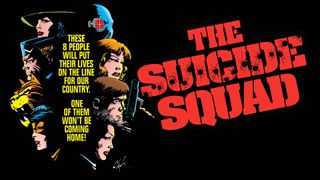Three decades ago in the DC comic book series Legends, readers were introduced to a government official named Amanda Waller, a.k.a. 'The Wall.' The Wall had a plan to deal with problems that needed to stay out of the public eye and that regular superheroes wouldn't touch: Send supervillains in to do the dirty work, in exchange for time off their sentences.
Outfitted with explosive collars to prevent betrayal and guided by such equally-damaged government employees as Rick Flag, this motley crew became the headliners of Suicide Squad, a book unlike anything regular readers of the DC Universe were used to seeing at the time.
Missions were tinged with real-world countries and politics - and rarely ended with a clean-cut victory. Previously minor characters, ranging from Deadshot to Bronze Tiger and even Captain Boomerang, were fleshed out with complex personalities and a self-destructive edge. The Squad lived up to the expendable quality of its name - characters died frequently, and they were often the ones who seemed the most heroic and/or competent. And the moral and ethical quandaries the Squad's mere existence posed hovered over the proceedings, with everyone from the government to other heroes doing everything from trying to manipulate the Squad's missions to getting them shut down for good.
On August 5, the Squad returns to theaters with a tone from writer/director James Gunn that is even more loyal to the original formula of the Suicide Squad comic books.
Newsarama assembled our own Squad-of-sorts in the form of the creators responsible for the versions some of the characters you'll see on screen for a special oral history of the Suicide Squad.
In this retrospective, the creators reminisce about how the book came about, the origins of the characters, and much, much more.
Secret Origins of the Suicide Squad
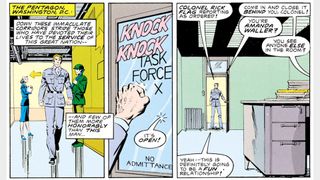
Mike Gold (editor, Legends): This series started as a discussion between John Ostrander and Bob Greenberger, although John wasn't writing for DC as of yet. I think it might have been Bob who suggested reviving the name 'Suicide Squad.'
Robert Greenberger (editor, main Suicide Squad series): John Ostrander and I had met as con road warriors and I was already a fan of his First Comics work so it was natural we'd want to work together. He first pitched Challengers of the Unknown, but Dick Giordano, our executive editor, said it was already promised.
Around that time, Legal would circulate a list of titles that needed to be used or DC might lose the trademark, and 'Suicide Squad' was on the list.
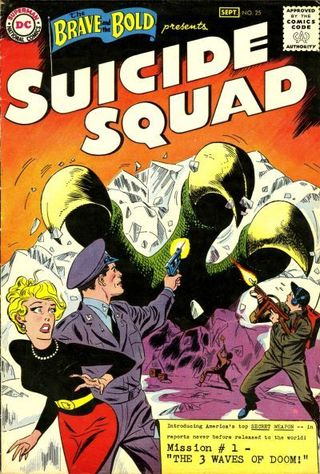
Gold: That title - like several other '50s launches (Danger Trail, The Brave and the Bold) - 'Suicide Squad' originally was used as the title for a pulp magazine series.
Greenberger: While not a big fan of the Kanigher-Andru-Esposito stories from The Brave and the Bold, I found something catchy about the name. I pitched it to John; he wasn't biting at first but the more he thought about it, the warmer he grew.
John Ostrander (writer/creator, Suicide Squad series): At first, I thought the premise was over-the-top. Then Irangate came about, and suddenly the concept of the Squad seemed much less far-fetched.
Gold: When I left First Comics to come over as DC's senior editor - later group editor and director of editorial development - it was with the understanding that I could bring over many of the folks I enjoyed working with at First. John was my initial choice, and when Dick Giordano asked me to develop the sequel event to Crisis on Infinite Earths (while I was still in Chicago and isolated from the NYC staff; this was Dick's idea). John was my choice for plotter.
Bob Greenberger was assigned as my assistant editor, which was great as he was a friend whose professional work I respected. John told me about his discussions with Bob and, since my main purpose for the Legends mini-series was to use it as the launching pad for a number of new projects (such as the Wally West Flash and the Justice League) I thought Suicide Squad was a great idea to add.
John developed the story as well as the character of Amanda Waller in Legends, obviously, to great effect.

Ostrander: I still get some residuals for creating Amanda Waller. Many of the other characters already existed.
Greenberger: John was in Chicago, and this was the mid-'80s, so email was a ways off. So we spent a lot of time on the phone. We talked themes and story concepts. I poured through Who's Who in an effort to find characters we could use, especially cannon fodder, but also recognizable ones no one wanted to use at the time.
Ostrander: The Flash had just been rebooted in Legends, and they weren't interested in using his rogues gallery, but we didn't really kill any of them off, though we used Captain Boomerang and later Captain Cold. I was writing Firestorm's book, so yeah, I had free rein on killing off Firestorm villains.
Greenberger: I immediately latched on to John's idea for a full supporting cast working at Belle Reve, which gave us characters we could own and work with long-term.
Ostrander: Belle Reve was a concept I was very proud of, because at that point there was no specific prison in the DC Universe for holding metahumans.
Luke McDonnell (artist, Suicide Squad main series and Deadshot limited series): Designing Belle Reve was a lot of fun. I got to create a prison!
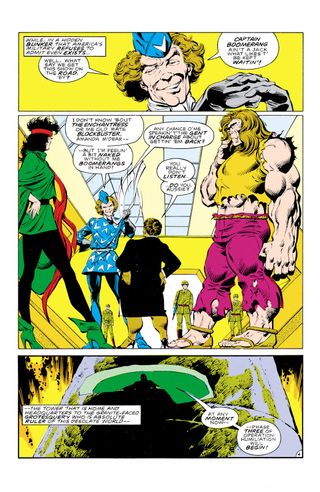
Greenberger: Later on, once Luke McDonnell and Karl Kesel were brought on board, we arranged conference calls and meetings at cons where practical.
Karl Kesel (inker, main Suicide Squad series): I'd been inking the Legends mini-series, which introduced the Suicide Squad. Remember, this is back when the lettering was actually on the art, so I got to read the comic book as I inked it.
As pages came in and I realized what John Ostrander was doing - the Dirty Dozen with super-villains - right away I thought 'This is genius!' Very soon after that, I started to lobby editor Bob Greenberger to let me ink the Squad's monthly title. Luke was already onboard as penciler. I finally wore Bob down and he gave me the gig - probably just to get me out of his hair!
Greenberger: Luke was more laconic, eager to draw new settings and characters.
Ostrander: With Luke, I wrote the book Marvel-style because he was so good at breaking down scenes into little moments – giving them this cinematic quality. I wanted to write around that.
McDonnell: John's scripts were done Marvel-style – there'd be this very, very detailed plot, and I'd break it down into pages and panels, and then he'd go back and dialogue it. It made for a very close collaboration.
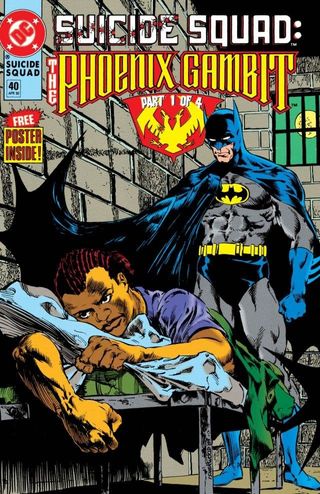
Geof Isherwood (artist, second half of main Suicide Squad series): John - and Kim Yale, I must include - wrote very tight, very well-constructed scripts. Drawing at Marvel, I was used to the plot method, and totally expected to adapt that plot synopsis into storytelling and pages. What I immediately appreciated from the full scripts was knowing the dialog, so matching acting and expressions to what the characters were saying was much easier to do. And, given that they thought out their stories quite thoroughly, I rarely felt the need to deviate from that script for the sake of clearer storytelling.
Kesel: The thing I enjoyed most, without a doubt, was how collaborative John wanted the process to be. He said he saw us as a band, and we were all trying to make the best music possible, so however that happened was cool with him.
We each had our role to play - John on lead guitar, Luke on keyboards, I guess maybe I was drums - but we could all suggest things to the others. Whatever made the work better. That was one of the best lessons I ever learned in this industry and, quite honestly, it's something I do to this day on any project I work on myself.
I took full - and probably unfair - advantage of this crack-in-the-door and started sending John long, hand-written letters filled with ideas about the Squad. Long letters. I believe his wife Kim named them 'Kesel Epistles.'
John was unfailingly gracious - never complained, never told me to go jump in a lake - and actually incorporated a number of my suggestions into the book. To my great joy.
Ostrander: The briefing scenes came about because I hadn't done a team book before. In the storylines, the team was often split up into several groups of smaller characters, and this was an opportunity to not only establish what the story was about, but to get them all in one place and let them bounce off each other. It was inspired by TV shows like Hill Street Blues, which was popular at the time.

Kesel: John's writing was electrifying. Very exciting, very intense. Also: very funny. He constantly - constantly - took B-, C-, and D-level characters and didn't just make them interesting, he made them memorable.
Greenberger: The book worked because in 1987 there were just a few team books at each company, and they were all heroes.
Adam Glass: (writer, 'New 52' Suicide Squad): I use to get my comic books from this candy store in the Bronx and I remember seeing that amazing Suicide Squad #1 cover by Howard Chaykin.
And it was this great picture of all these bad guys, I've seen most of them before, but a few I hadn't. Then it says: "These 8 people will put their lives on the line for our country. One of them won't be coming back!" And I was in. Bad guys? Someone's going to die? Where do I sign up?
Ostrander: We ripped a lot of our plots from the headlines. The first issue of Suicide Squad opens with what appears to be terrorists taking out an airport full of people. I'm not sure they'd let us do a story like that today. We always tried to keep one foot grounded in the real world.
The Wall
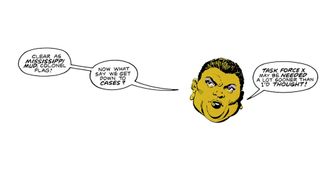
Gold: It was Amanda Waller that made the series unique. John created Amanda out of whole cloth, basing a few of her nuances on people he knew in Chicago.
Glass: Amanda Waller 'The Wall' was a badass. She would take on Batman and call him "rich boy." She knew his secrets and let him know it. Even Superman was scared of Batman, but not the Wall. Black, female, looked like your aunt, come on, you weren't seeing that anywhere else but Suicide Squad.
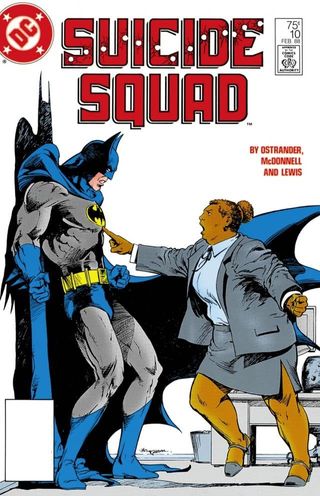
A favorite moment – Suicide Squad #10. Batman, disguised as Matches Malone, sneaks into Belle Reve to steal some info and has it out with Waller, who gets the better of him.
Gold: Launching Amanda (in Legends) was wonderful and great fun - watching the reaction was great fun. When I got in the back seat, watching Amanda take on Batman was just a joy.
Ostrander: Amanda Waller was truly like a wall, the way Luke drew her - I loved what he brought to the character. When we got to go into her background, we saw the way something like that forged you. She was pragmatic, pure and simple.
Kesel: The Wall is one of the best characters introduced in comics in the last 30 years. Totally unique. I haven't kept up with all her incarnations, but I feel very strongly that if she isn't an overweight black woman - which instantly makes her someone who is both underestimate and highly intimidating - a lot of the point of the character's been missed.
Deadshot
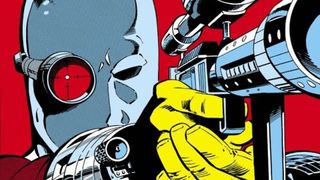
Kesel: Deadshot was, of course, the book's break-out character. And a favorite of mine as well.
Ostrander: Deadshot was a character they'd introduced in the '50s, and then didn't reintroduce him until the '70s, with this brilliant costume design by Marshall Rogers. And then they didn't do much with him after that, except appear in Batman anniversary issues.
I based his characterization on an interview I'd seen on TV with a hitman - just this cold, emotionless, matter-of-fact person. He said he didn't value his life, why should he value yours?

Kesel: Suicide Squad #22 - when Deadshot shoots the Senator who's blackmailing the Squad - is still, to this day, the one comic I'm most proud to have worked on. I still have all the original art from the story's climax, and it's never leaving my hands.
Ostrander: That moment, where Deadshot shoots Senator Cray so Flag won't - that was a defining moment, for that character and for the Squad.
Kesel: In the moment Deadshot shoots the Senator, he is the story's hero and villain - something I've never seen in comics before or since. I'm very proud to have been a small part of that.
But.
That storyline was in John's original outline for the Squad - and in that outline Deadshot died in the hail of bullets following the Senator's death. And I still think he should have died.
Yes, that would have deprived us of a great character, but it's the one time I saw John's fondness for a character soften what he did to the character. On one hand, yeah - I'm glad Deadshot is still around. John made him into a great character! But - that would have a been such a great death.

Greenberger: Killing Deadshot would have been a ballsy move, but the Bat-office liked what we were doing with him, and felt there was a place for him down the road. Additionally, we were free to do the miniseries, and killing him didn't fit those plans.
Ostrander: The Deadshot miniseries let us get into the psychology of the character. Floyd idealized his brother, and in trying to 'save' him, Floyd accidentally kills him, and that set Floyd down this path. It was dark, but you know, if you read noir, you know you have to go all the way. The cast of characters in this miniseries was so twisted that Deadshot came out looking pretty well.
McDonnell: The Deadshot miniseries, that was the first time I got to ink my own stuff. It's some of my favorite work.
Ostrander: It was my favorite collaboration with Luke. The end of issue #3, where Deadshot tortures and kills the man who killed his son, and slowly pulls off his mask, and the last page is this splash-page close-up of him screaming "I'm coming home, Ma!"– that's one of my favorite sequences ever.
Captain Boomerang

Kesel: If you had told me a year earlier that I'd like Captain Boomerang -that he'd be one of my favorite characters and I'd be pushing for a one-shot starring him - I would have laughed in your face. And yet... that's the magic of John's writing.
Ostrander: Captain Boomerang was so much fun, because as low as you thought he could sink, he'd find another level to sink. Of everyone on the Squad, he's the only one who's comfortable with who he is.
One of my favorite issues with Luke is the one where he's been impersonating Mirror Master to commit crimes while not on Squad duty, and he has to keep going back and forth, changing costumes, like an old farce.
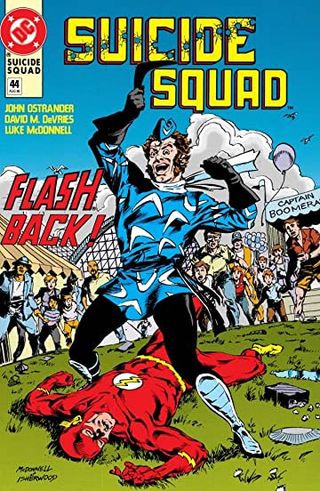
Kesel: The thing I liked most about John's Boomerang was that he had a real personality! He was an unrepentant sociopath who was constantly gaming the system. He was, as they say, clearly the star of his own, inner movie. When Waller tells everyone on the Squad that they're expendable, you know Boomerang looked around and thought 'Yeah, right. They certainly are.' But he never thought that applied to him.
I loved that he did the bare minimum to stay on the Squad. He certainly wasn't someone I'd trust. But John gave him an easygoing charm that made him tolerable, otherwise I'm sure Deadshot or someone else would have put him out of their misery about two issues into the series! He's the sort of character who's great to watch from a distance, but you would absolutely hate in real life.
I pushed and pushed for a one-shot with the character - which, at one point, was supposed to be written by John, laid-out by Keith Giffen, with me supplying finished art; I even roughed out a logo! It didn't happen, but it would have been sweet…
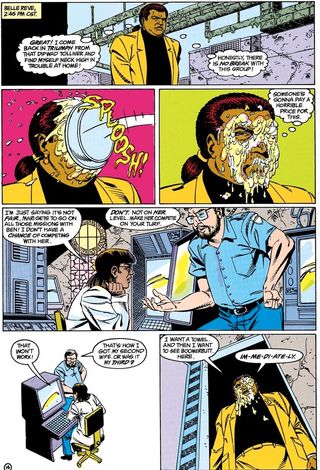

Greenberger: We got to make Captain Boomerang a real corrupt villain, first with masquerading as Mirror Master to avoid Waller, and then the whole pie gag.
Ostrander: The pie in the face gag - we stretched that out for two years.
Kesel: Funny story: I wanted to do an arc in Superboy guest-starring the Squad, and I ran into a lot of resistance. The Squad's own book had just been canceled, and the thinking was: sales clearly indicate there's no interest in these characters. Why use them? But I love the Squad, stood my ground, and did the three-part 'Watery Grave' story. (The first time King Shark worked with the Squad, I'll point out).
I said it wasn't the Squad without Waller, Deadshot, and Boomerang - and those are the only characters I was cleared to use. Everyone else came from the Superboy book. Which was fine with me - it's still one of my favorite Superboy stories.
There was talk at the time about killing Boomerang in one of the big events that was being planned - no idea which - and I begged them to let me kill him in my Superboy story instead. If he was going to die, I wanted him to be killed by someone who loved him. In the end, they only let me maim him - I had Deadshot shoot him in both hands. Can't remember what happened with Boomerang after that - he's dead now? Replaced by his son or something, right?
DC's always had trouble with older characters - feels the fans can't relate to them.
The thing with Boomerang is - yes, he was older, he was balding- but that was part of the point. He was an old dog who couldn't learn new tricks! Not only couldn't - didn't want to! And the fact that he was older proved he was good at what he did. It worked for him. He was a survivor! None of that comes through with a younger character. Oh, well...
The body count

Ostrander: You never knew who we were going to kill.
The challenge was establishing characters within such a short space. Shrike was an interesting example. She has these funny/horrifying moments talking to Father Craemer, and you find out she's been abused and has this tragic element to her backstory, and then she's killed off, all in one issue.
No one was a redshirt…okay, Grant Morrison was, I'll cop to that. The idea was they'd written themself into the continuity when they appeared in Animal Man, and so I killed them off to set them free.
The important thing with Rick Flag's death was the readers knew, 'If they can kill off Rick Flag, they can kill off anybody.' It raised the stakes for everyone.
We made it look like Amanda was killed at one point – she was shot at least once, but I was never going to kill Amanda, any more than I was ever going to kill Boomerang or Deadshot. I was having too much fun with them.
Just before Rick Flag went out on his final vendetta, we did a crossover special with the Doom Patrol, and Rick had a separate team for that one…and we killed them all off! Rick was the only one who walked out alive on that one. It was the Squad taken to the nth degree.
Greenberger: I don't recall arguing against anyone's death, although it took some editorial arm twisting to let me use some of the bigger-name villains such as the Penguin. Once we took off and got some acclaim, that became easier.
Personal Favorites

Greenberger: Karl would draft his long, enthusiastic letters, which we called 'Kesel Epistles'.
Kesel: The biggest one (they used) was probably that the Female Fury Lashina should lose her memory and join the Squad under some other identity. I didn't have a name, just that she should have a Really Big Gun. (I suggested this right after seeing the movie Aliens. Go figure.) John took the idea, named the character 'Duchess,' and made the character so much more than just a fan-boy rip-off.
Greenberger: All credit to Karl for pushing us to use the Female Furies and the whole Duchess subplot which took two years to pay off. That was a particular favorite.
Ostrander: Lashina gets stuck on Earth, so she adopts another identity so she can survive and find her way back to Apokalips and take revenge on Bernadeth, who got her stranded there.
The thing with Darkseid is he has this physical power, but what's greater is his Machiavellian mind. He can punch you through a wall, but going back to Jack Kirby, he can outthink, outplan you.

McDonnell: Drawing the Kirby stuff was great - I always wanted to do stuff like that. Kirby was a major influence of mine, so getting to draw those characters was exhilarating.
Ostrander: Looking back, I wondered, 'Was that even feasible, Amanda Waller standing up to Granny Goodness?' But it was fun, and we got to do it in a way that didn't make Granny a lesser character.
Isherwood: I knew Barbara Gordon had been Batgirl, so I drew her accordingly, personality-wise.
Kesel: Punch and Jewelee. Another set of characters who I never-in-a-million-years thought I'd have any interest in. Yet John made them twistedly memorable. I liked them so much I begged to do their Who's Who page -and to this day it's a piece I'm proud of. (There was talk about a Punch and Jewelee one-shot as well, with me on art and John and his wife Kim on story. I'm sure that would have been horrible, wonderful fun.)
Glass: I loved Bronze Tiger. There were not a lot of African-American characters in comic books when I was growing up. So, to see a diverse character who happened to be a kung fu masters, with a mysterious background, and a strong moral code was refreshing and cool as hell. And you were lucky to see one diverse character in a comic book, but Suicide Squad had two, with him and Amanda Waller.
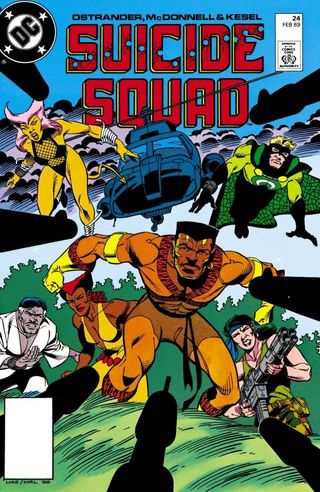
Ostrander: I always liked Shade the Changing Man – we were given permission to only use him temporarily, with the knowledge he was going to go off in his own mature readers book, and we wouldn't be able to use him.
What I wanted to play with regarding the Penguin is that sometimes he's very silly-looking and silly-acting, but to last as long as he has, he's got to be a criminal mastermind. So we took him out of his normal element, his outfits, the umbrellas –he had to rely on that mind of his. And I wound up getting to do more with that in Penguin: Triumphant a few years later, and they used that characterization for years afterward, there are elements of it in Gotham.
Dr. Light - the thing about him was, it looked like he had a hood ornament on his head. And at that point he'd been defeated by children - it seemed like every time he turned around, the Teen Titans trounced him, Little Boy Blue and the Blue Boys beat him. What self-respect could he have? He'd lost his mojo. If later writers decided to give it back, fine, but without that, he was completely pathetic, and he was funny. He hits himself with a pie at one point, just because he wants to be part of the team, and everyone else has been hit with a pie. He hits himself with a pie and makes it look like someone else did it.
Isherwood: I thought Boomerang was fun to do, supplying comic relief, and Poison Ivy was also fun, as she tried to be smart-ass and seductive at the same time. Deadshot was cool too. And, Nightshade, Bronze Tiger, and Vixen were also characters I looked for in upcoming scenes. In reality, you have to get interested in anyone you draw, or it shows. But those were the best. And Waller grew on me as time went on. (No pun intended). She was kind of a Yang to Kingpin's Yin.
The more I drew them all, the more they became like family, I suppose. I was quite disappointed the comic got canceled, because I felt the series still had a lot of great stories to tell at that time.
The 'New 52' reboot

Isherwood: I would say the first thing is Harley Quinn came along too late! John's take on her, her failings, her reaction to abuse, etc.would have fit in marvelously with the rest of the team.
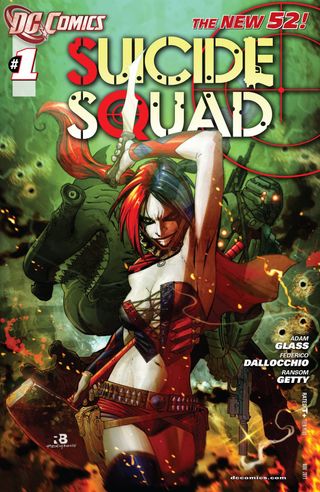
Glass: DC knew my writing from Marvel's Deadpool, Luke Cage, and CW's Supernatural. I did some smaller books for them, and they asked me if I wanted to do a book, which would it be? And I said Suicide Squad, and they said okay.
Pat McCallum was my editor, and is a guy who deserves a lot of credit. When I told him I wanted Harley on the team he didn't blink, he instantly saw it and helped me get DC to approve it. And she was the game changer.
Deadshot was a no-brainer, there is no Squad without Floyd. And I loved what Gail Simone had done with King Shark, so I knew he'd be fun, and I wanted Boomer back for sure, and everyone else fell in line.
I thought John did such a great job tackling world issues, so I wanted my book to feel like a runaway train. Humor, character, story, conflict, and action were the goals.
Why the Suicide Squad can never die
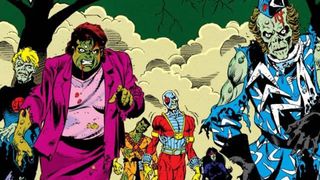
Gold: Why has the Squad proven to be such an enduring concept? Amanda Waller. Pure and simple (to say about a character who, indeed, is neither). She is unique and John's handling of the character was spot-on.
And kind of courageous for the time: there weren't a lot of large black women bossing male characters around - you know, like the Batman - and getting away with it.
Kesel: As for the Squad's cult following: like they say in West Side Story - When you're a Jet, you're a Jet all the way. People who love the squad love the Squad. And I'm certainly one of them.

And, really, that comes down to John's writing, and the creative environment he encouraged. John was doing things that had never been done in comics before. And in a way we were working under the radar, so we could get away with these things! It was very exciting and energizing, and that always comes through on the page. Always.
Greenberger: One of the original run's strengths - and one overlooked by subsequent editors and teams - is that we mixed heroes in need of redemption with villains hoping for redemption or release. Each was on the team for a reason, and as John explored those reasons, they grew and changed from Nemesis to Nightshade to Deadshot and so on.
These were characters that were different by the time I stopped editing with #31 from when we first introduced them in issue #1.
Glass: It's about the bad guys doing good. The villain being a hero. It's about redemption, and I think we all can relate to that.
Kesel: I've worked on a lot of great comics in my career. Been lucky enough to work with some of the top writers and artists in the field. And I would drop everything in a New York minute to work with John on Suicide Squad again.
Live or die, these are the greatest Suicide Squad members of all time.
[Editor's Note: This article was originally published in 2016.]
